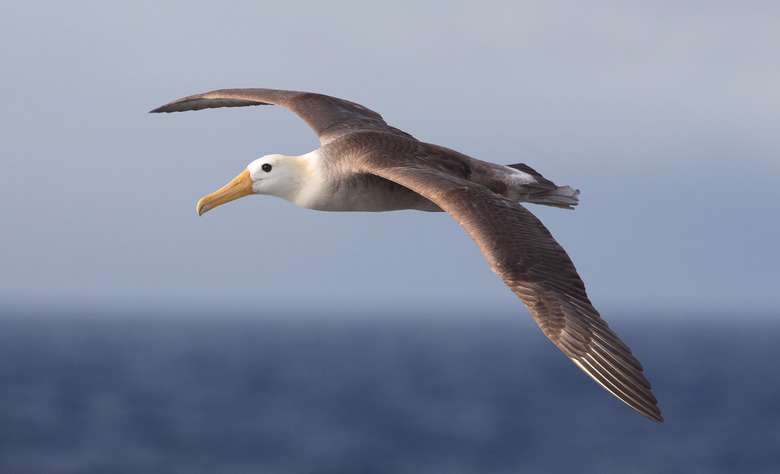Endangered Plants & Animals List
Across the planet, as habitats are lost and populations are decimated, there are thousands of plants and animals that stand on the brink of extinction and are considered endangered. Many of these have protections afforded to them by organizations, laws and governments. Among the thousands, the World Wildlife Fund has a list of 36 that are considered priority species in the race against extinction. According to the WWF, one of the reasons these 36 are considered a "priority" is because efforts beyond just conserving their habitats must be made if they are to be guaranteed future survival.
Additional criteria for being listed as a priority are that the species is key to the food chain, helps to stabilize or regenerate its habitat, is important for the health of communities or is an important cultural icon.
Albatross
Albatross
Among the 36 priority species is the albatross, four species of which are considered to be critically endangered. These are the Amsterdam, Chatham, Tristan and Waved albatrosses. Six additional species — the Northern Royal, Black-Footed, Sooty, Indian Yellow-Nosed, Atlantic Yellow-Nosed and Black-Browed albatrosses — are endangered. Albatrosses are the largest flying bird and spend 80% of their lives at sea. These birds, which only come to land for breeding, form lifetime pairs.
Cacti
Cacti
Cacti are among the plants listed as a priority. According to the World Wildlife Fund, cacti are uniquely adapted to their habitats and define many of the landscapes in which they are found. Cacti are important sources of water for many animals in their ecosystems, and provide nesting places for many types of birds. Because of collection and habitat loss, many species are near extinction. In addition to these threats, a freeze in Mexico's Altiplano reduced some cacti populations to just 5% of what they had been.
Ginseng
Ginseng
Ginseng is an herb that has been used throughout the world for its medicinal qualities since ancient times. When Asian ginseng was no longer able to meet the demand of the market, wild North American ginseng began to be harvested and exported. Ginseng grows slowly, taking up to six years to reach maturity. In addition to over-harvesting, ginseng is threatened by habitat loss. Most wild-growing ginseng is found in forests, which are being cleared for logging and development.
Giant Panda
Giant Panda
A member of the bear family, the Giant Panda is threatened by loss of its forest habitat and fragmented populations. Poaching is also a threat to the panda. There are more than 50 panda reserves that protect nearly half of the Giant Panda's remaining habitat. About 980 pandas, which make up roughly 61% of its entire population, live on the reserves.
Polar Bear
Polar Bear
The polar bear is an endangered species that has gained attention in the debate over climate change. The polar bear is the largest terrestrial carnivore on earth. An excellent swimmer, the polar bear seeks a habitat where ice covers the arctic sea throughout the year. Polar bears mate, rear their young and hunt in this setting. According to the World Wildlife Fund, the polar bear is important in conservation because it is at the top of its food chain. Polar bears are threatened because of melting sea ice.
Tigers
Tigers
Like the polar bear, the tiger is important in conservation, because it too is at the top of the food chain in its ecosystem. Three of the nine tiger subspecies are already extinct, and only about 4,000 tigers exist today in the wild. Tiger populations are threatened most by human activity, which includes poisoning, trapping, snaring, shooting and capturing the big cats.
Cetaceans
Cetaceans
Cetaceans include whales, dolphins and porpoises. Among the 80 species in this class, many are on the verge of extinction. All cetacean species are offered some protection under the Marine Mammal Protection Act, and those that are considered endangered or threatened are protected under the Endangered Species Act. According to the International Union for Conservation of Nature, the 10 most endangered cetaceans species are the Vaquita porpoise, the North Pacific right whale, the North Atlantic right whale, the South Asian river dolphin, the Atlantic humpback dolphin, Hector's dolphin, Chilean dolphin, Franciscana porpoise, Australian snubfin dolphin and Indo-Pacific humpback dolphin.
Cite This Article
MLA
Foster, Bethney. "Endangered Plants & Animals List" sciencing.com, https://www.sciencing.com/endangered-plants-animals-list-5365747/. 22 November 2019.
APA
Foster, Bethney. (2019, November 22). Endangered Plants & Animals List. sciencing.com. Retrieved from https://www.sciencing.com/endangered-plants-animals-list-5365747/
Chicago
Foster, Bethney. Endangered Plants & Animals List last modified March 24, 2022. https://www.sciencing.com/endangered-plants-animals-list-5365747/
